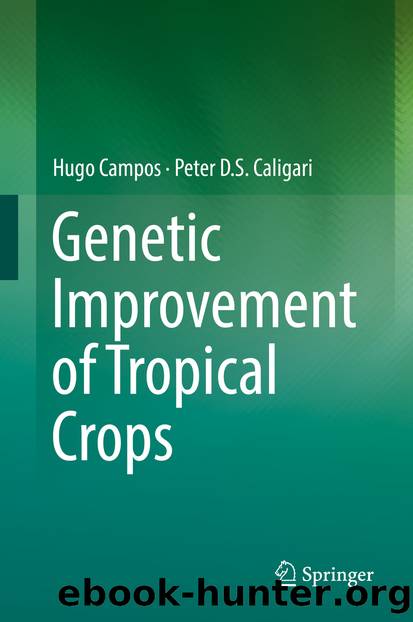Genetic Improvement of Tropical Crops by Hugo Campos & Peter D. S. Caligari

Author:Hugo Campos & Peter D. S. Caligari
Language: eng
Format: epub
Publisher: Springer International Publishing, Cham
5.11.4 Genomic Selection
Genomic selection (GS ) simultaneously tags many loci across the entire genome to estimate genomic estimated breeding values or GEBV. It offers several advantages and overcomes key problems of MAS based on QTLs. Key among the different advantages is that several different traits can be improved simultaneously through a selection index , similar to those based on phenotypic traits and economic values. de Olviera and co-workers suggested the potential of GS for cassava in 2012. GS was also proposed for other crops (Heslot et al. 2012) characterized by the fact that breeding is based on the use of inbred progenitors. Different articles emphasize that GS would maximize genetic gains by unit of time (De Oliveira et al. 2012; Heffner et al. 2009). Like conventional breeding, GS has serious limitations for the selection of low narrow-sense heritability traits because of their low additive genetic effects in relation to the phenotypic variance. Genotype-by-environment interactions also affect the precision of GS estimates as well as the relatedness among genotypes. Ceballos et al. (2015) predicted that GS would be effective in high-heritability traits such as plant architecture, pest and disease resistance or DMC. However, GS was not expected to be efficient in improving FRY because of the relatively high influence of nonadditive genetic effects and the large within-family genetic variation generated by the heterozygous progenitors used in cassava (Table 5.1). Other factors may limit further the usefulness of breeding value in cassava (Ceballos et al. 2016a; Joaqui et al. 2016).
There is an ongoing project (NextGen Cassava Project ) to test GS in cassava led by Cornell University with field work in Uganda and Nigeria (Rabbi et al. 2015). As expected, GS is proving to be efficient improving traits such as resistance to CMD (Wolfe et al. 2016b; Rabbi et al. 2014a). Whereas DMC was also increased considerably, progress increasing FRY was, as predicted, not satisfactory (Wolfe et al. 2016a). An honest assessment of cost/benefit for technologies such as GS will have to be made in the years to come. It should be pointed out that improving resistance to CMD or increasing DMC is not enough for such an expensive approach that has the additional restriction of the need of âclosedâ breeding populations. The use of inbred progenitors would overcome some of the problems that implementing GS in cassava has. The induction of flowering would also benefit greatly the success of GS. Alternatives of GS combined with reciprocal recurrent selection would also be an interesting approach to overcome, at least partially, the problems of nonadditive genetic effects influencing FRY, which is ultimately the most important trait to improve.
Download
This site does not store any files on its server. We only index and link to content provided by other sites. Please contact the content providers to delete copyright contents if any and email us, we'll remove relevant links or contents immediately.
Sapiens: A Brief History of Humankind by Yuval Noah Harari(14160)
Sapiens by Yuval Noah Harari(5259)
Pale Blue Dot by Carl Sagan(4855)
Homo Deus: A Brief History of Tomorrow by Yuval Noah Harari(4772)
Livewired by David Eagleman(3619)
Origin Story: A Big History of Everything by David Christian(3589)
Brief Answers to the Big Questions by Stephen Hawking(3315)
Inferior by Angela Saini(3208)
Origin Story by David Christian(3115)
The Gene: An Intimate History by Siddhartha Mukherjee(3012)
Signature in the Cell: DNA and the Evidence for Intelligent Design by Stephen C. Meyer(2995)
The Evolution of Beauty by Richard O. Prum(2910)
Aliens by Jim Al-Khalili(2760)
How The Mind Works by Steven Pinker(2694)
A Short History of Nearly Everything by Bryson Bill(2574)
Sex at Dawn: The Prehistoric Origins of Modern Sexuality by Ryan Christopher(2439)
From Bacteria to Bach and Back by Daniel C. Dennett(2421)
Endless Forms Most Beautiful by Sean B. Carroll(2399)
Who We Are and How We Got Here by David Reich(2373)
